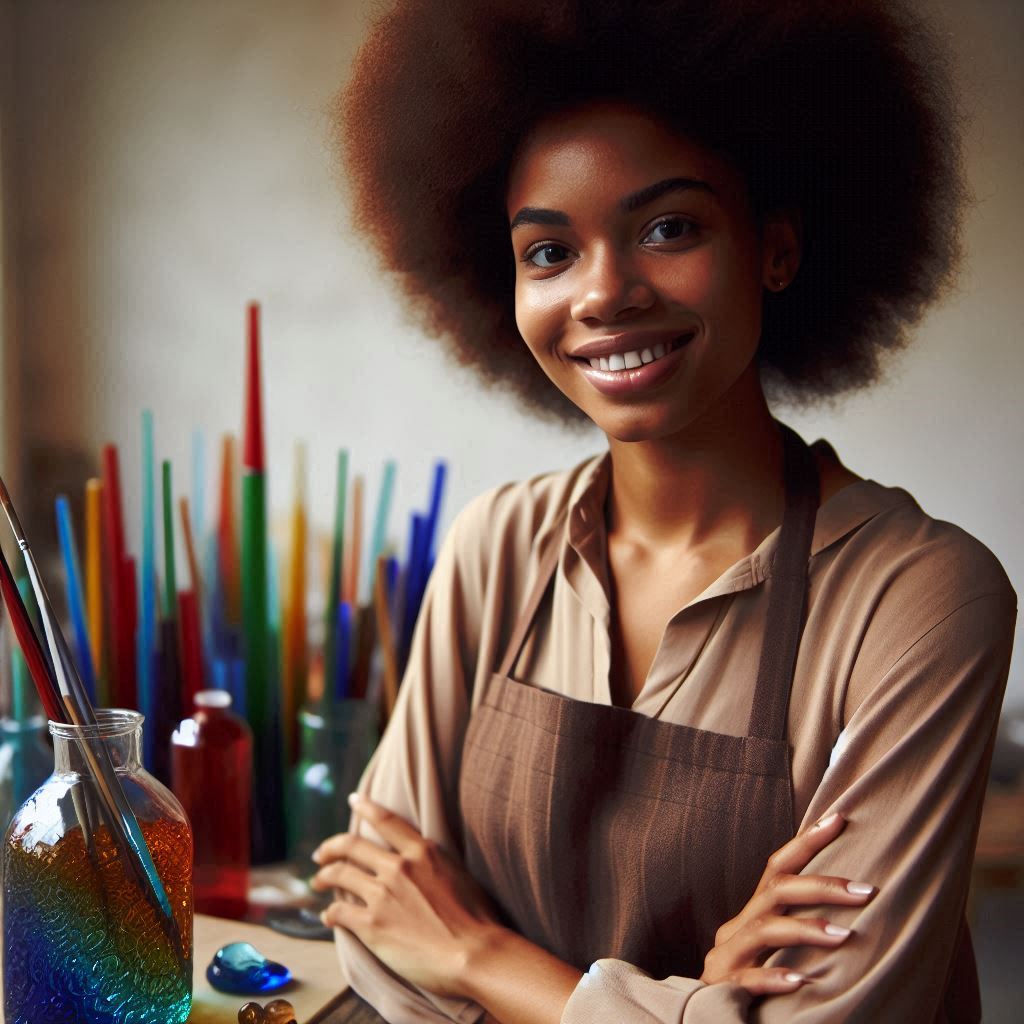Introduction
Glass art offers an exciting and visually stunning way to express creativity.
For beginners, exploring glass art techniques can be both rewarding and transformative.
This post introduces the basics of glass art, emphasizing why it‘s a fantastic choice for budding artists.
Glass art involves various techniques to manipulate glass into beautiful, functional pieces.
For beginners, starting with basic techniques is crucial.
Common methods include stained glass, fused glass, and mosaic glass.
Each technique allows for unique artistic expressions and results.
The popularity of glass art has surged recently.
More people are drawn to its intricate beauty and the meditative process of creating it.
Social media platforms showcase stunning glass art pieces, inspiring many to try their hand at this craft.
Glass art classes and workshops are now widely available, making it easier for beginners to start their artistic journey.
Learning glass art techniques offers numerous benefits for beginners.
It enhances fine motor skills and promotes patience and precision.
Engaging in glass art can also be a therapeutic outlet, helping to reduce stress and foster relaxation.
Additionally, mastering glass art can open doors to new creative opportunities and provide a sense of accomplishment.
In summary, glass art techniques offer a rewarding experience for beginners.
The growing popularity of this art form makes it an accessible and exciting creative outlet.
Learning these techniques not only fosters artistic skills but also provides personal fulfillment and relaxation.
Whether for personal enjoyment or potential career paths, exploring glass art is a valuable and enriching endeavor.
Understanding Different Types of Glass
Glass art offers various techniques, each with unique characteristics and challenges.
Transform Your Career Today
Unlock a personalized career strategy that drives real results. Get tailored advice and a roadmap designed just for you.
Start NowThree popular methods are stained glass, glass fusing, and glass blowing.
Understanding these can help beginners choose their preferred technique.
Stained Glass
Stained glass involves cutting colored glass into pieces and fitting them together with lead or copper foil.
This technique is commonly used in windows and decorative panels.
Stained glass is known for its vibrant colors and intricate designs.
The primary challenge is achieving precise cuts and seamless joins.
Beginners should focus on mastering cutting tools and soldering techniques.
Glass Fusing
Glass fusing involves melting glass pieces together in a kiln.
This technique allows for creative freedom, as different glass types can be fused to create colorful, abstract designs.
The main challenge is controlling the kiln temperature to avoid overfusing or underfusing the glass.
Beginners should learn about kiln settings and experiment with different glass types to understand their behavior when heated.
Glass Blowing
Glass blowing requires heating glass until it’s molten and then shaping it using a blowpipe.
This technique creates intricate shapes and designs.
It is dynamic and physically demanding, requiring precise control of the molten glass.
Challenges include maintaining consistent temperature and working quickly before the glass cools.
Beginners should start with basic shapes and practice controlling the glass’s temperature and movement.
Resources for Beginners
To dive deeper into these techniques, beginners can explore several resources.
Online tutorials and video demonstrations offer visual guidance for all three methods.
Local community colleges and art schools often provide workshops and courses.
Showcase Your Business Today
Reach thousands of readers actively exploring professional services. Publish your business profile and grow your audience now.
Publish NowJoining online forums or social media groups dedicated to glass art can also provide valuable tips and support from experienced artists.
By exploring these techniques and utilizing available resources, beginners can develop their skills and find their niche in the captivating world of glass art.
Read: Printmaking: DIY Projects for Beginners
Essential Tools and Materials for Beginners
Starting with glass art can be exciting and fulfilling.
To get started, beginners need a few essential tools and materials.
Here‘s a guide to help you begin your glass art journey.
Basic Tools and Materials
- Glass Cutter: This tool is essential for scoring glass before breaking it.
Choose a glass cutter with a carbide wheel for smooth cuts. - Breaking Pliers: These pliers help break scored glass along the lines.
They apply pressure evenly to snap the glass cleanly. - Running Pliers: These are used to break larger pieces of glass or to separate intricate designs.
They work by applying controlled pressure. - Glass Grinder: This tool smooths the edges of cut glass and shapes pieces precisely.
It has a rotating diamond bit to grind glass efficiently. - Copper Foil Tape: This tape wraps around the edges of glass pieces for stained glass projects.
It allows for the soldering process. - Soldering Iron: Essential for joining glass pieces together.
The soldering iron melts solder, which binds the glass with copper foil. - Solder: Use lead-free solder for safety.
It melts and solidifies to hold pieces together securely. - Glass Cleaner: Keep your glass pieces clean and free from dust.
This ensures better adhesion and a clear finish.
Purpose and Function of Each Tool
Each tool has a specific role.
The glass cutter scores the glass, while breaking pliers and running pliers help break it along the score lines.
A glass grinder refines edges, and copper foil tape prepares edges for soldering.
The soldering iron and solder connect glass pieces, and glass cleaner maintains cleanliness.
Cost-Effective Options
For beginners on a budget, opt for basic versions of these tools.
Look for starter kits that include essential tools.
Online marketplaces and local craft stores often have affordable options.
Second-hand tools can also be a cost-effective choice.
Starting with these tools will set a strong foundation for your glass art practice.
As you progress, you can invest in advanced tools and materials. Happy crafting!
Read: Exploring Printmaking in Graphic Design
Safety Precautions When Working with Glass
Importance of Safety Gear
Always wear gloves, goggles, and aprons to protect yourself from cuts and burns.
Invest in high-quality safety gear to ensure maximum protection while working with glass.
Make sure your work area is well-ventilated to minimize exposure to fumes from melting glass.
Handling Glass Safely
Never touch the hot glass directly; always use tools or tongs to handle it.
Avoid rushing or being distracted while working with glass to prevent accidents.
Keep your work area clean and organized to reduce the risk of tripping or knocking over glass objects.
Safety Guidelines for Beginners
Start with simple projects before attempting more complex designs to build skill and confidence.
Take breaks regularly to prevent eye strain and fatigue, which can lead to accidents.
Familiarize yourself with the specific safety guidelines for the type of glass art technique you are using.
Read: Best Glass Art Schools in the USA

Techniques for Cutting and Shaping Glass
Cutting and shaping glass may seem daunting, but mastering these techniques can transform you into a skilled glass artist.
Demonstrate Proper Techniques for Cutting Glass Using a Glass Cutter
Begin by selecting the right glass cutter.
A basic tool with a carbide wheel works well for beginners.
Place the glass on a flat surface and use a cutting mat to protect the surface beneath.
Mark your cut line with a pencil.
Hold the glass cutter like a pen, applying even pressure as you draw it along the marked line.
Ensure a continuous, smooth motion.
Avoid pressing too hard; this can cause uneven cuts or breakage.
After scoring the glass, use running pliers to snap the glass along the score line.
How to Shape Glass Pieces Using Tools Like Pliers and Grinders
Once your glass is cut, shaping it requires additional tools.
Use breaking pliers to refine edges by gently squeezing the glass.
For more intricate shaping, employ a glass grinder.
The grinder‘s rotating wheel smooths rough edges and shapes the glass more precisely.
Showcase Your Business Today
Reach thousands of readers actively exploring professional services. Publish your business profile and grow your audience now.
Publish NowPlace the glass on the grinder‘s platform and move it against the rotating wheel, applying gentle pressure.
Ensure you keep the glass moist to avoid overheating.
Step-by-Step Instructions for Beginners to Practice Cutting and Shaping Glass
- Setup: Secure your glass on a cutting mat and mark the desired cut lines with a pencil.
- Cutting: Use the glass cutter to score along the marked lines, applying even pressure.
- Breaking: Snap the glass along the score line using running pliers.
- Shaping: Refine edges with breaking pliers. For detailed shaping, use a glass grinder.
- Smoothing: Run the glass against the grinder‘s wheel to smooth and shape edges, keeping the glass moist.
Practice these steps regularly to build confidence and improve your glass cutting and shaping skills.
With time, your precision will enhance, and you’ll create beautiful glass art.
Read: How to Price Your Printmaking Artwork
Introduction to Basic Glass Art Designs
Glass art offers endless possibilities, especially for beginners eager to explore its beauty.
Starting with simple designs can build confidence and skill.
This section introduces basic glass art designs using stained glass and glass fusing, perfect for newcomers.
Showcase Simple Designs That Beginners Can Create with Stained Glass or Glass Fusing
Stained glass art involves cutting glass pieces and assembling them into a pattern.
Beginners might start with basic shapes like squares, triangles, and circles.
Simple designs such as small suncatchers or coasters are ideal first projects.
Glass fusing, on the other hand, involves melting glass pieces together in a kiln.
Beginners can create designs like small pendants or decorative tiles.
These straightforward projects teach fundamental techniques and help develop an understanding of glass behavior.
Provide Templates or Patterns for Beginners to Use as a Starting Point
Templates and patterns serve as valuable tools for beginners.
They offer a clear guide for cutting and assembling glass.
Free online resources or pattern books can provide a range of designs from geometric shapes to simple flowers.
Using templates helps beginners learn the basics of glass cutting and placement, making the learning process more manageable and enjoyable.
Encourage Creativity and Experimentation with Different Design Ideas
Once comfortable with basic techniques, beginners should embrace creativity.
Experimenting with colors, textures, and shapes can lead to unique and personalized designs.
Trying different glass types, like opaque or transparent, can also yield interesting effects.
Encouraging experimentation not only enhances skills but also helps discover personal style.
By starting with simple designs, utilizing templates, and embracing creativity, beginners can build a strong foundation in glass art.
This approach ensures a rewarding and enjoyable introduction to this beautiful medium.
Find Out More: Interactive Media Design Certifications Guide
Firing and Annealing Glass
The Process of Firing Glass in a Kiln for Fusing or Slumping
Firing glass involves heating it in a kiln to a specific temperature.
For fusing, glass pieces are melted together, creating a seamless design.
Slumping, on the other hand, shapes glass by softening it to conform to a mold.
Set your kiln to the appropriate temperature for your glass type and project.
Monitor the heating process closely, as precise temperature control is crucial for successful results.
The Importance of Annealing Glass to Prevent Cracking or Breaking
Annealing is a crucial step after firing.
This process involves gradually cooling the glass to relieve internal stresses.
Without annealing, glass may crack or break due to uneven cooling or residual tension.
Set your kiln to cool slowly, following the recommended annealing schedule for your glass type.
Proper annealing ensures durability and longevity of your finished glass pieces.
Tips on How to Achieve the Desired Results When Firing and Annealing Glass Projects
To achieve the best results, start by thoroughly cleaning your glass to avoid imperfections.
Use accurate thermometers and pyrometers to monitor kiln temperatures.
Always preheat your kiln to avoid thermal shock to the glass.
When setting your kiln’s firing schedule, follow specific guidelines for each project.
Ensure the annealing cycle is long enough to properly relieve stress.
Showcase Your Business Today
Reach thousands of readers actively exploring professional services. Publish your business profile and grow your audience now.
Publish NowRegularly check kiln maintenance to prevent malfunctions.
By following these tips, you will improve your chances of creating high-quality glass art.
By understanding and mastering these techniques, you can elevate your glass art projects and achieve professional-quality results.
Discover More: Crafting Unique Jewelry: Tips and Tricks
Troubleshooting Common Issues in Glass Art
Glass art can be both exciting and challenging, especially for beginners.
Knowing how to troubleshoot common issues can enhance your learning experience.
Identify Common Problems
Beginners often face several issues in glass art.
Bubbles in the glass are frequent, caused by trapped air or moisture.
Uneven melting can occur due to inconsistent heat or incorrect kiln settings.
Color distortion happens when colors mix unintentionally or when there is improper kiln temperature.
Recognizing these problems early helps in addressing them effectively.
Solutions and Tips
To tackle bubbles, ensure your glass is clean and dry before firing.
Use a torch or kiln to gently remove trapped air.
For uneven melting, verify that your kiln‘s temperature is consistent and appropriate for the type of glass.
Adjust your kiln’s ramp and hold settings as needed.
To prevent color distortion, use compatible glass types and ensure proper temperature control.
Test small samples to see how colors react before committing to a full project.
Learning from Mistakes
Mistakes are part of the learning process in glass art.
Document each issue and its resolution to build a personal reference guide.
Analyze what went wrong and why, then experiment with adjustments in your technique.
Join glass art communities or workshops to gain additional insights and tips from experienced artists.
Continuous practice is key.
Over time, your skills will improve, and you‘ll encounter fewer problems.
By identifying common problems, applying practical solutions, and learning from each experience, you can enhance your glass art projects and build confidence.
Keep experimenting and refining your techniques to grow as a glass artist.
Conclusion
In this blog post, we explored essential glass art techniques for beginners, including fusing, stained glass, and mosaic art.
Glass fusing involves melting pieces of glass together at high temperatures to create intricate designs.
This technique is perfect for beginners due to its versatility and ease of use.
Stained glass art, on the other hand, combines colored glass pieces into beautiful patterns, held together by lead or copper foil.
It allows for creative expression and results in stunning, light-enhanced pieces.
Mosaic glass art involves assembling small glass tiles into patterns or images.
This method is excellent for those looking to experiment with shapes and colors.
Each technique has unique characteristics and applications, offering endless creative possibilities
As you explore these methods, remember that each technique requires practice and patience.
Experiment with different styles, colors, and patterns to find what resonates with you.
Don’t be afraid to make mistakes; they often lead to unexpected discoveries and improvements.
Encouragement is key in your glass art journey.
Dive into new projects with enthusiasm and curiosity.
Participate in workshops or join online communities to share your work and gain feedback.
These interactions can provide valuable insights and inspire further creativity.
Showcase Your Business Today
Reach thousands of readers actively exploring professional services. Publish your business profile and grow your audience now.
Publish NowContinue learning and developing your skills.
The world of glass art is vast and ever-evolving.
Stay motivated by setting small, achievable goals and celebrating your progress. Remember, mastery comes with time and experience.
Keep experimenting, stay curious, and most importantly, enjoy the process of creating beautiful glass art.
Your journey in glass art is just beginning, and the possibilities are as limitless as your imagination.
[E-Books for Sale]
The Big Book of 500 High-Paying Jobs in America: Unlock Your Earning Potential
$19.99 • 500 High-Paying Jobs • 330 pages
Explore 500 high-paying jobs in America and learn how to boost your career, earn more, and achieve success!
See All 500 High-Paying Jobs of this E-Book
1001 Professions Without a Degree: High-Paying American Jobs You Can Start Now
$19.99 • 1001 Professions Without a Degree • 174 pages
Discover 1001 high-paying jobs without a degree! Unlock career tips, skills, and success strategies for just $19.99!




